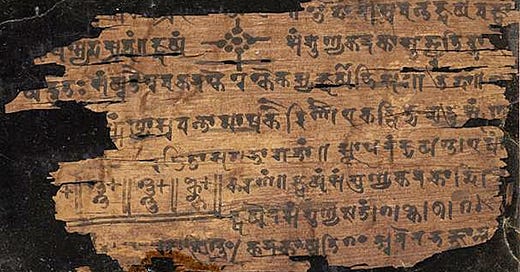When the Void Whispers
Dr. Maya Sharma faced quantum riddles when a Dunhuang text whispered of perception’s power. She stopped.
Dr. Sharma’s research grappled with the quantum measurement problem: why does a system’s state solidify only when observed? The wave function, a cornerstone of quantum theory, captures this ambiguity:
Here, the superposition of states—each with amplitude (c_n)—persists until measurement collapses it into a single outcome. The Tibetan manuscript she held described shunyata—emptiness—as a condition where phenomena lack inherent essence, manifesting only through observation (Early Buddhist Manuscripts | NEH). This wasn’t a vague metaphor. It suggested a relational ontology, akin to quantum theory’s rejection of intrinsic properties absent interaction. Could shunyata prefigure the observer-dependent reality encoded in von Neumann’s measurement chain?
She turned to quantum entanglement, where the universe reveals deeper ties. Two particles, once linked, share a state defying spatial separation. The entangled wave function might read:
Measuring one instantly fixes the other, a phenomenon tested via Bell’s Inequality:
When (S > 2), as experiments confirm, locality collapses (Quantum Entanglement | Scientific American). The manuscript’s pratityasamutpada—interdependent origination—mirrors this: existence as a web of mutual causation, no element independent. Did Buddhist meditators intuit a non-local fabric science now probes with photon detectors?
Her inquiry pressed further. Consciousness, elusive to physics, beckoned. The Integrated Information Theory (IIT) posits it as a property of systems with high Φ, a measure of integrated complexity:
where (I) quantifies mutual information across system subsets (Consciousness and IIT | Frontiers). The Lankavatara Sutra frames consciousness differently—not as a static entity but as alaya-vijnana, a base awareness arising from interdependent processes, layered and impermanent (Lankavatara Sutra | Terebess). IIT’s focus on integration parallels this, but the sutra’s fluidity—mind as a recursive flux—hints at a dynamic beyond current models. Might consciousness be the fulcrum where shunyata and quantum collapse converge?
Historical threads enriched the puzzle. The Bakhshali manuscript’s zero, a Buddhist contribution, reframed mathematics (Bakhshali Manuscript | Wikipedia), while Gandharan monks tracked celestial cycles with precision (Buddhism Origins | Stanford). At Nalanda, 5th-century debates on cosmology rivaled Greek academies (Nalanda University | UNESCO). These weren’t incidental. They suggest a tradition attuned to formal systems—perhaps even proto-scientific.
A marginal sketch in the manuscript—a mandala of nested spirals—drew her eye. It evoked quantum field theory’s path integrals, where a particle’s trajectory sums all possible paths:
Feynman’s formulation maps probabilities across infinite histories (Feynman Diagrams | Physics Today). The mandala lacked numbers, yet its structure whispered of multiplicity resolving into unity. She considered quantum cosmology—wave functions of the universe itself, like Hartle-Hawking’s no-boundary proposal. Did the mandala encode an early intuition of such totality?
The text’s closing line—“When the seen and seer fade, what persists?”—resonated with Wheeler’s participatory universe, where observation shapes reality’s genesis (Wheeler’s Participatory Universe | APS). The Dalai Lama’s reflections in The Universe in a Single Atom bridged these realms, urging scrutiny of such alignments (Dalai Lama | Universe in a Single Atom). Dr. Sharma stepped back, equations and parchment side by side. The connections weren’t proofs—they were invitations, threads stretching across disciplines and millennia.
Outside, the stars gleamed, silent. She returned to her work, the manuscript’s weight lingering. Its concepts—emptiness, interdependence, awareness—interlaced with equations in ways that defied dismissal. The void wasn’t empty. It was full of questions.
Sources
• Early Buddhist Manuscripts | National Endowment for the Humanities
• Buddhism and its Origins | Stanford Report
• Bakhshali Manuscript | Wikipedia
• Quantum Entanglement | Scientific American
• Consciousness and Integrated Information Theory | Frontiers
• Lankavatara Sutra | Terebess
• Feynman Diagrams | Physics Today
• The Universe in a Single Atom | Dalai Lama
• Nalanda University | UNESCO
• Wheeler’s Participatory Universe | APS










Aliha. Awesome!! Which dali lama are you referencing.
The end of science is Buddhism; at the deepest level, science and Buddhism may be interconnected.